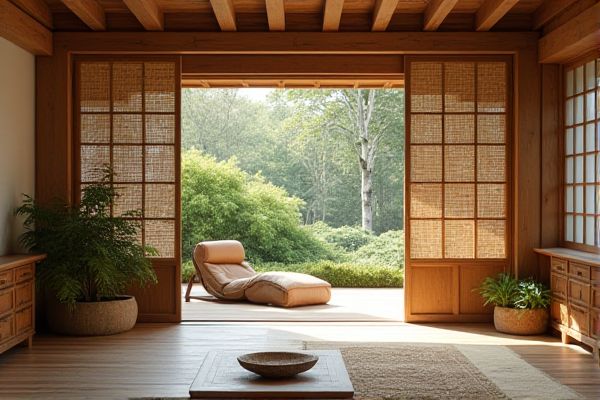
Bamboo screens offer natural durability and a rustic aesthetic, perfect for creating privacy with an eco-friendly touch, while lattice screens provide a more structured, decorative pattern that supports climbing plants and adds architectural interest to your outdoor space. Discover the key differences and choose the ideal screen to enhance Your garden by reading the rest of this article.
Table of Comparison
| Feature | Bamboo Screen | Lattice Screen |
|---|---|---|
| Material | Natural bamboo stalks | Wood or vinyl strips in crisscross pattern |
| Durability | Moderate, weather-resistant with treatment | High, especially vinyl lattice |
| Privacy | Good opacity, blocks view effectively | Partial privacy, gaps between lattice |
| Installation | Simple panel setup, lightweight | Requires framing, moderate effort |
| Maintenance | Needs periodic sealing or staining | Low maintenance, easy cleaning |
| Aesthetic | Organic, tropical look | Classic, geometric design |
| Cost | Moderate price range | Varies, vinyl is cost-effective |
Introduction to Bamboo Screens and Lattice Screens
Bamboo screens offer a natural, eco-friendly option crafted from sustainable bamboo stalks, providing privacy while enhancing outdoor aesthetics with a tropical, organic feel. Lattice screens feature a crisscross pattern typically made from wood or vinyl, delivering versatile design options for garden trellises, fences, or decorative partitions. Your choice depends on whether you prefer the rustic warmth and sustainability of bamboo or the customizable structure and classic style of lattice screens.
Material Composition and Sustainability
Bamboo screens are crafted from natural bamboo stalks, offering a renewable and biodegradable option that grows rapidly, making them highly sustainable compared to traditional wood. Lattice screens, typically made from treated wood, vinyl, or composite materials, vary in sustainability depending on the source and production process but often involve more synthetic treatments. Bamboo's low environmental impact and quick regrowth cycle position it as a superior eco-friendly choice over many lattice screen materials.
Visual Aesthetics and Design Versatility
Bamboo screens offer a natural, organic aesthetic with warm tones and unique textures that bring an earthy charm to outdoor and indoor spaces. Lattice screens provide a more structured, geometric pattern that enhances visual interest while allowing customizable designs for privacy and light diffusion. Both options support versatile design applications, but bamboo excels in creating a rustic or tropical ambiance, whereas lattice suits modern, classic, or minimalist decor styles.
Privacy and Shade Capabilities
Bamboo screens offer superior privacy due to their dense natural fibers that block visibility while providing moderate shade, making them ideal for creating secluded outdoor spaces. Lattice screens feature an open-grid design that allows for partial visibility and light passage, delivering limited privacy but enhancing airflow and filtered shade. Choosing between bamboo and lattice screens depends on the desired balance between privacy control and sunlight diffusion in garden or patio settings.
Durability and Weather Resistance
Bamboo screens offer moderate durability with natural resistance to moisture and insects but may degrade over time when exposed to harsh weather conditions without proper treatment. Lattice screens, typically made from vinyl or treated wood, provide superior weather resistance and longevity, maintaining structural integrity under varied climatic conditions. Choosing lattice screens ensures enhanced durability and requires less maintenance compared to untreated bamboo options.
Installation Process and Maintenance
Bamboo screens feature lightweight panels that simplify installation, often requiring only basic tools and minimal wall attachment, while lattice screens may demand more precise measurements and hardware for secure assembly. Maintenance of bamboo screens involves regular cleaning with a soft cloth and occasional sealing to prevent moisture damage, whereas lattice screens, usually made from wood or vinyl, benefit from repainting or power washing to maintain durability and appearance. Both options require monitoring for wear, but bamboo's natural fibers need more frequent treatment to resist weathering and insect infestation.
Cost Comparison and Budget Considerations
Bamboo screens generally offer a more affordable option compared to lattice screens, making them ideal for budget-conscious projects without compromising natural aesthetic appeal. Lattice screens, often crafted from wood or vinyl, tend to have higher upfront costs due to material quality and customization options, which might be justified by longer durability and design versatility. Your budget will determine the best choice, balancing initial investment against maintenance expenses and desired longevity.
Best Applications and Outdoor Uses
Bamboo screens excel in outdoor applications such as garden privacy fences, patio enclosures, and natural windbreaks due to their durability and eco-friendly properties. Lattice screens offer versatile outdoor uses including trellises for climbing plants, decorative garden partitions, and shaded porch panels that enhance aesthetic appeal and airflow. Both options provide effective solutions for enhancing outdoor spaces, with bamboo favored for rustic, natural looks and lattice preferred for customizable patterns and structural support.
Environmental Impact and Eco-Friendliness
Bamboo screens offer a highly sustainable option due to bamboo's rapid growth rate and ability to regenerate quickly without extensive resource use, making them an eco-friendly choice for outdoor privacy. Lattice screens, often made from treated wood or synthetic materials, may involve more intensive manufacturing processes and chemical treatments that increase their environmental footprint. Choosing bamboo screens reduces carbon emissions and supports renewable resource use, contributing significantly to greener landscaping solutions.
Conclusion: Choosing the Right Screen for Your Space
Bamboo screens offer natural durability, eco-friendliness, and a warm aesthetic ideal for creating serene outdoor retreats. Lattice screens provide versatile design options and enhanced airflow, perfect for decorative privacy and supporting climbing plants in your garden. Your choice depends on whether you prioritize sustainable materials and a rustic look or customizable patterns and functional ventilation.
 homyna.com
homyna.com